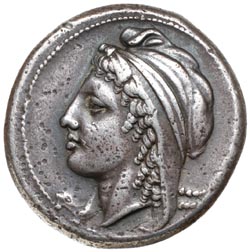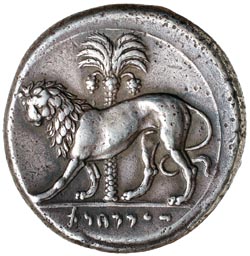The Hannibal Collection of Carthaginian Coins
Lot 3756 Session 14 (11:30am Thursday 28th July) The Hannibal Collection of Carthaginian Coins
Estimate $20,000
Bid at live.noble.com.au
SOLD $35,000
SICULO-PUNIC, (c.320-315 B.C.), (Carthaginians in Sicily), silver tetradrachm, (17.05 g), obv. head of Tanit (Dido) to left wearing oriental tiara beneath which are visible the corkscrew curls of her hair, dotted border, rev. lion walking to left with its head three-quarters face to left; palm tree with date clusters in background, Punic legend "SMMHNT" (= "People of the Camp") in exergue, (S.6433 [p.595], Jenkins, SNR 56, 270 - 5 [dies 083/R224 this coin], SNG Lloyd 1628 [this coin], Gulbenkian 376 [same dies], Jameson 911 [same dies], Kraay-Hirmer 209 [same dies]). One of the masterpieces of the Siculo-Punic coinage, a few minor surface blemishes, grey tone, otherwise good very fine and very rare.
Ex Count Torremuzza Collection (c.1780's); ex Lloyd Collection; ex Triton I Sale December 2-3, 1997 (lot 393, illustrated and it realised US$7,187) and Freeman & Sear Fixed Price List 5, Spring 1998, (No.E52 at US$8,750) and Noble Numismatics Sale 64 (lot 2436).
Jenkins records ten examples from this pair of dies with a total of fifteen left facing heads from two obverse and two reverse dies. The right facing head comes from one pair of dies.
Undoubtably one of the most remarkable tetradrachms types ever issued, since it shows a successful blending of Greek and non-Greek elements. The general type itself is known for only three obverse and three reverse dies. Its place of mintage remains uncertain, though the Greek engraver was clearly an artist of the highest calibre. The legend only tells us that it was an issue of "people of the camp", a designation that is shared with many other Siculo-Punic issues. The iconography is of particular interest as the distinctive female head in an oriental tiara usually is taken to represent Dido the legendary queen and founder of Carthage (814 B.C.). Dido was also known as Elissa the daughter of a king Pygmalion of Tyre (825-813 B.C.), but the portrait is more likely to be of Tanit the great Punic goddess. The reverse shows a prowling lion before a palm tree which could possibly be a reference to the recruitment of large numbers of Libyans into the Carthaginian army as a move to counter the new threat posed by Agathocles of Syracuse. Jenkins (SNR 56, p.26) makes the intriguing suggestion that when Carthage adopted a new aggressive policy under the leadership of Hamilcar, son of Gisgon, these coins were possibly presentation pieces for that elite battalion of two thousand citizens which headed the armada. (Diodoros XIX, 106). Hamilicar might also have had these coins struck for those Sicilian Greeks, who were mainly exiled Syracusans serving in his army.
An example of the second die type (No.271) sold for 63,250 SFr. in October 1999 in Leu Sale 76 held in Switzerland (lot 68) and another example from the same dies realised US$38,000 in NFA X auction sale of September 17 and 18, 1981 (lot 78).
The provenance of Count Torremuzza is interesting as related in this following account: J.W. Goethe "Italian Journey [1786-1788]" Penguin edn.1970 (p.244), notes for the day 12th April 1787 when visiting Palerno in Sicily that :
"Today we were shown Prince Torremuzza's collection of coins. I went there almost reluctantly. I understand too little about this field, and a merely inquisitive tourist is the bane of the true connoisseur. But after all, one has to begin somewhere, so I relented and derived great pleasure and some profit from our visit.
The ancient world was dotted with cities and even the smallest of them has left us, in its precious coins, a record, if not of the whole course of art history, at least of some epochs of it. An eternal spring of art's immortal fruits and flowers smiled up at us out of these drawers, telling of a craftsmanship perfected and practised over a lifetime, and of much else besides."
Estimate / sale price does not include buyer's premium (currently 22% including GST) which is added to hammer price. All bids are executed on the understanding that the Terms & Conditions of sale have been read and accepted. For information on grading and estimates please refer to the Buying at Auction advice.
Quick find
View a lot by number and sale.
Adjacent lots
Lot 3754
SICULO-PUNIC, mint of the camp, (c.320-310 B.C.), silver tetradrachm, (16.19 g), obv. wreathed head of ...
Estimate $600
Lot 3755
SICULO-PUNIC, mint of the camp, (c.320-310 B.C.), silver tetradrachm, (16.91 g), obv. wreathed head of ...
Estimate $1,500
Lot 3756 This lot
SICULO-PUNIC, (c.320-315 B.C.), (Carthaginians in Sicily), silver tetradrachm, (17.05 g), obv. head of Tanit (Dido) ...
Estimate $20,000
Lot 3757
SICULO-PUNIC, (c.320-315 B.C.), (Carthaginians in Sicily), silver tetradrachm, (16.82 g), obv. head of Tanit (Dido) ...
Estimate $10,000
Lot 3758
SICULO-PUNIC, mint of the camp, (c.300-290 B.C.), silver tetradrachm, (16.92 g), obv. head of young ...
Estimate $1,500

